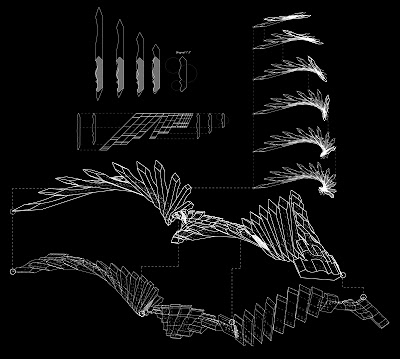Here are my notes from
Rajchman, Grounds:
This essay uses the word ‘ground’ as a starting point from which to unfold architectural / philosophical possibilities.
For Wolfflin, ground has to do with a basic formlessness. The will, as a vital force in immanent things must try to overcome this formlessness. ‘Force of form’ pulls us up from formlessness. Notions of regularity, proportion and symmetry derive from this idea.
In The Radiant City, Le Corbusier declares ‘natural ground’ to be the bearer of disease, and the ‘enemy of man.’ Thus buildings should be separated from natural ground. Severing the relationship to ‘natural ground’ gives a building an autonomy; it is free to become monochromatic planes set on pilotis barely touching the ground.
This is a type of un-grounding, a freedom from the weight of tradition. Artificial rather than natural, abstract rather than figural (abstract in the sense of a universal language reproducible anywhere).
Oppositional ways of thinking about ground:
- natural vs. artificial
- organic vs. abstract
- figural vs. geometric
- contextual vs. abstract
Replacing the first with the second is meant to bring about a ‘revolution.’ What non-oppositional ways are there to consider the issue of ground?
Questions concerning ground (and becoming ungrounded) will address the following:
- a move away from ‘proper’ visual form, form-giving movement prior to the ground
- becoming ungrounded is not something that happens once and for all, but it is a potential force
- notions of history or memory that move away from progressive time to more complex time
At a certain point in Eisenmann’s work, he treats urban sites as superimposed layers of ‘memory’. The ‘geology’ of urban memories can then be reconfigured to produce a type of ungrounding. The artifice generated here is different from Le Corbusier’s artifice, more Piranesi than Mondrian.
For Eisenmann, fiction comes before narrative and sure judgment, he moves away from “progressivism” and the idea of a complete-able architectural revolution toward something more like Borges’ garden of forking paths. Joints of time can come out of joint.
Matta-Clark’s cuts through buildings (unbuilding or undoing) provide another way out of contextualism. His interventions were seen as a resistance to attempts to revive the context of the historical city through architectural form.
This may be seen as a continuation of Smithson’s notion that the Earth is not a stable ground, but an entropic force, constantly undoing formal structures.
Another type of ungrounding derives from ‘dynamic topologies’ the move away from classical relations between gravity and vision, weight and upright posture. In this case, formlessness becomes a positive feature of space.
“…the faceless figures in the painting of Francis Bacon reveal an undoing of the Albertian relations between face and ground in favor of another kind of corporeal space shown as well in the loss of the skeleton/flesh relation, flesh becoming “meat” – soft, malleable, perhaps even bloblike.”
Groupe Espace (Virilio, Parent) spoke of rejecting vertical and horizontal axes in favor of the oblique – a move that should redefine architecture. Oblique function allowed for planes oriented toward movement and a ‘re-eroticization’ of the ground as a folded or pleated force-field.
This reflected Merleau-Ponty’s idea that the ground in architectural space should be a part of a more general rediscovery of the body, a phenomenological critique of abstract Cartesian space.
Virilio departs from the traditional phenomenological view of a corporeally grounded ‘lived’ space in which the Earth is stable, and instead works with a dynamic conception of the body. These movements are not about going from one fixed point to another, but are traces of an unbounded space.
Virilio says that we are constituted by a ‘corporeal “trajectivity” prior to our subjectivity and objectivity.’ This is another way to imagine becomings of cities and bodies and the spaces in which these becomings transpire.’
As axonometric drawing can produce an overly rectilinear, segmented view of space that dynamic topology can overcome, a programmatic view of space can produce an overly operational view of space that might be superseded by a more affective diagram. What types of spaces might this thinking imply?
We must understand ourselves as vague or indeterminate beings prior to being tied to fixed grounds.
Indeterminate spatial beings are not calculating individuals, members of organic communities, or participants in civil society. Instead our social beings are intersections and assemblages of indefinite trajectories through time and space.
‘Traditional’ social space is said to be grounded in tradition and possibly even in a specific location. The individual is an integral member of an organic whole. ‘Nurturing community.’
‘Modern’ social space is ungrounded from tradition and location. The individual is an atom drifting through undifferentiated space. ‘Possessive individual.’
As an alternative, modernity is a process that turns us into indeterminate beings that do not fit into grounded collective narratives and are not simply individual units in self-organizing processes. “The modern world unleashes patterns of demography or migration that put people in situations where…they are no longer able to tell straight narratives of their ‘origins.’”
We are all potential ‘anybodies,’ the life of a body is indefinite, ungrounded. There is something ‘yet to be constructed’ in an anybody. And this ‘yet to be constructed’ is particular. We are at once close to (particular) and far from (indeterminate) ourselves.
Once the life-world is understood as being ungrounded, we are free to move with lightness. “Movement and indetermination belong together, neither can be understood without the other.”







